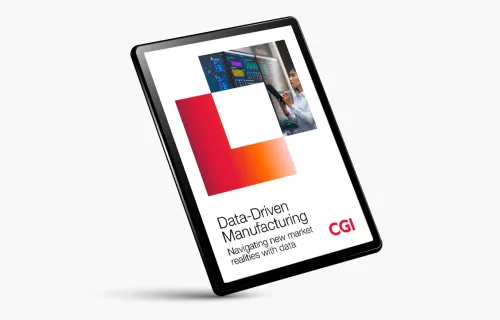Utilities are dealing with exponential growth in the volume and complexity of data. At the same time, they are readying for the energy transition by preparing networks to support electrification and increased use of renewable energy resources, like wind, solar and tidal, which are intermittent and less dependable.
To be successful, utility leaders need to make the right decisions at the right time. This requires data to be at the heart of the decision-making process. It must be accurate, reliable, complete, relevant and timely to help guide and prioritize decisions.
Effective data governance—which defines how an organization produces and consumes data while being organized to make data-driven decisions—is essential to achieving these requirements. Data governance that enables “speed to trusted action”—not restriction—is the key to success.
The energy future depends on data
All elements of the energy transition are increasingly dependent on data:
- Future system-wide access with local flexibility (e.g., distributed resources, smart photovoltaic inverters, battery storage, smart EV charging, and more) requires reliable and real-time data to manage the connected distribution system, avoid congestion on the distribution grids, postpone investment while maximizing the use of distribution assets, and integrate renewable energy sources.
- Integrated network management solutions, like distributed energy resource management systems (DERMS) and advanced distribution management systems (ADMS), use advanced data analytics to support grid operators and advanced grid planning solutions. This helps distribution system design engineers prioritize grid investments (e.g., prediction tools to improve maintenance predictability of energy assets).
- Improving the customer experience and engagement, new customer platforms, and innovative approaches to attract and retain customers in DER programs requires actionable data, as does asset maintenance, repairs, upgrade plans, replacements for obsolescence, predictive maintenance and overall asset management.
- Activating climate pledges calls for building, connecting and tracking sustainability data across the value chain to measure and demonstrate progress, track goals and make informed decisions on how to decarbonize buildings and fleets and embed new ways of working to advance ESG goals.
Uncertainty has some utilities performing a balancing act
While all of the above is "within reach," there is uncertainty about the nature and pace of these initiatives. For instance, while intermittent generation is increasing steadily, the adoption rate of electrification and distributed generation—which could lead to voltage violation on distribution networks—is unclear. None of these has reached a point yet where they are truly disruptive to the grid.
As a result, some utilities are taking a cautious and balanced stance, preparing for the energy transition but remaining agile in their technology investments to develop the data capabilities needed to support transformation. However, utilities executives know that electrification and distributed generation can quickly accelerate and likely will be adopted in clusters across the distribution network, which will compound their impact.
Getting your data in order
What can you do now to prepare for the upcoming changes? A key first step is to get your data in order.
Effective data governance supports business strategy and objectives by determining how data management activities must be operationalized within the organization and across its ecosystem. It provides the management framework that ensures shared responsibility for data-related decisions through a detailed, accurate and integrated view of data. This requires:
- Envisioning the role of data in adapting business and operating models to meet the challenges of the energy transition
- Considering the strategic role of data management (this often is overlooked)
- Making a paradigm shift from highly formatted data to open and shared data, as this may be the preference of future legal and regulatory frameworks
- Enabling better collaboration, especially across organizational silos and between multiple market actors (e.g., transmission system operators, distribution system operators, generators, end users, aggregators, etc.)
- Improving agility and resilience in decision-making to embrace changing market trends, i.e., increased “speed to trusted action"
Benefits of data governance
Data governance is successful when fully integrated with business operations. It provides a holistic view of data-related business and technology activities to support effective decision-making in the face of transformation challenges. Specific benefits include:
- Decision-maker empowerment – Utilities executives need to make decisions faster and more efficiently by relying on reliable data models (i.e., ensuring integrated and appropriate network modeling) and leveraging data assets (e.g., reduced IT maintenance and increased analytics).
- Strategic alignment – Data governance can help utilities executives benefit greatly by ensuring data models and associated data assets are aligned with the organization’s needs and vision. It can reduce the cost and time to deploy solutions such as energy efficiency and demand response programs, marketing and customer engagement programs, DERMS and ADMS and improve effectiveness through enhanced operational excellence.
- Increased collaboration – Integrated and structured data governance across the utility enables better communication and collaboration between traditionally siloed teams and across market stakeholders. It also supports synergies between IT and business to effectively modernize information systems (e.g., data hubs, real-time demand response, etc.) and better control data assets (e.g., data analytics to support CAPEX and OPEX planning). Closer partnerships also improve operational efficiency (e.g., better security network systems and protection, reduced maintenance, etc.) and anticipation of transformation needs (e.g., phasing out security systems exposed to performance, security and legal risks).
- Continuous business process improvement – Data governance provides the management framework to identify the root causes that can affect operational efficiency and help prioritize decisions. It provides an opportunity to engage diverse teams to understand how data is used and how to use it better to drive change. Using data governance to enable more inclusive and integrated business processes empowers utilities to better identify improvement opportunities. For instance, how to integrate technologies, such as DERMS, with traditional system engineering and planning, or advanced demand forecasting tools to achieve business goals faster, or how to accelerate cloud modernization to unlock the potential of your energy assets.
- Modern data architecture – A key aspect of effective data governance is a modern data architecture to overcome data silos by providing an integrated view of critical data that resides in multiple systems, including legacy systems. Data governance promotes business-IT collaboration to maximize the value and diversity of data needed to manage networks effectively. For example, using the same dataset to run a predictive model to automate transport and distributed system design engineering, detect assets at risk of network outages, support equipment maintenance and prioritize work.
We invite you to listen to the Energy Transition podcast – A perfect storm for data and analytics to be the future of energy and utilities – by our colleagues on data governance and enablement for more perspectives on this topic and to contact us to discuss how we can work together to support your data journey.






